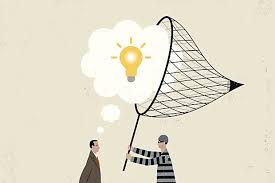Intellectual Property or ‘IP’ is a hot issue. It’s defined in the American Heritage Dictionary as “A product of the intellect that has commercial value” and by Commerce-database.com as “any product of human intellect that is unique and un-obvious with some value in the marketplace”.
IP begins as an idea about something new. The invention of a new kind of screw fastener or the creation of an original work of art is an idea turned into reality. The value comes in when that fastener or artwork turns out to have commercial potential.
“Intellectual property” includes the braking system on your car (patent), the content of the books you read (copyright), and the maker’s logo on your PC (trademark).
If you own the intellectual property rights for something you have the right to say who can use it and for what purposes. But you first have to establish your ownership of those IP rights.
If you’ve invented something you can protect your invention with a patent. If you’ve created a piece of software or a work of art you can protect it with a copyright. If your business has a logo or a unique name you can protect it with a trademark.
Patents
A Patent is a right granted by a national government in exchange for a complete disclosure of an invention. It gives the successful applicant the right to exclude others from making, using or selling the invention for a fixed period of time.
To be patentable an invention must be novel, it must not be obvious to a person skilled in the field of the invention, and it must have utility.
Patents stay within national boundaries and each country grants its own patents based on its own standards.
To get a patent the inventor files a formal application with appropriate authorities that discloses the substance of the invention and gives a sufficient written description to allow the public to make the invention.
The patent process can take several years, during which the invention is categorized as ‘patent pending’.
Copyright
Copyright is the exclusive right of the creator or any other copyright holder to reproduce a copyrighted work. It is sensible to advise others of your copyright by marking all copies of the work with a copyright notice.
Copyright exists as soon as a work of art or item of software is created, and registration is purely voluntary. Registration of a copyright will greatly assist the copyright holder to enforce his or her rights in case of a legal dispute.
Registration involves filing an application for copyright which in most countries requires completing a form, paying a small fee, and providing a copy of the work you want to copyright.
Copyright extends to other countries through the Berne Convention and Universal Copyright Convention although the term of a copyright depends on the applicable national law.
Incidentally, not all unauthorized use of copyrighted material is illegal. The public is allowed to make “fair use” of copyrighted material – usually for educational or other noncommercial purposes.
Trademarks
Trademarks protect business names, logos and other general visual attributes that distinguish a business from its competitors. The primary purpose of a trademark is to prevent confusion over a product’s origins, especially among consumers.
How to protect your IP
Protecting your intellectual property can be a short, simple and inexpensive process or a long, complex and expensive one depending on which sort of protection you require.
Copyright applications are pretty straightforward and require only a small amount of effort and a modest fee. You can file your own copyright application in most countries and not require the services of a lawyer.
Trademarks are another story. There are so many variables in a trademark application that the costs and length of time required can’t be generally estimated. They require the advice of a lawyer skilled in the field of trademarks and extensive searches to establish the uniqueness of your trademark.
The most expensive and complex cases are usually those involving patents. Again, the services of a specialist legal adviser will be required, and the secrecy involved in patent applications will cause extensive delays.
The first step to take in protecting your IP logically is to make an estimate of its value. If a copyright will provide sufficient protection you’re looking at the low-cost, fast and fairly simple end of the protective process. If on the other hand you want to register a trademark or apply for a patent the expenses and time involved will be significant.
Copyright 2002, RAN ONE Inc. All rights reserved. Reprinted with permission from www.ranone.com.

 Chris’ combination of academic credentials, career experience and temperament ideally suit his calling as a business development advisor. Clients say he has a mind for business and a heart for service.
Chris’ combination of academic credentials, career experience and temperament ideally suit his calling as a business development advisor. Clients say he has a mind for business and a heart for service.